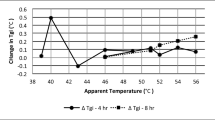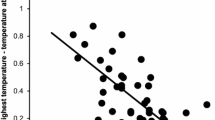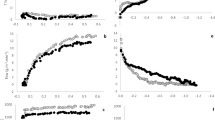Abstract
The purpose of this study was to test the hypothesis that under controlled surf conditions, sex differences in skin temperature exist, but core temperature would not vary between sexes when performing a simulated surf session while wearing a 2-mm wetsuit. Twenty male and 13 female surfers engaged in a 60-min simulated surf protocol using a custom 2-mm wetsuit in an Endless Pool Elite Flume with water temperature set to 15.6 °C. Participants were instrumented with a heart rate monitor, eight skin temperature sensors, and a disposable sensor for measurement of core temperature. The surf simulation consisted of paddling, duck-diving and stationary activities at three paddling speeds (1.2, 1.4 and 1.6 m/s). Participants were asked their thermal sensation periodically during the protocol, and all data were collected at 1-min intervals. Results indicated no significant differences in core temperature between males (37.31 ± 0.35 °C) and females (37.32 ± 0.48 °C, p = 0.995). Upper arm and thigh skin temperatures were significantly lower in females (27.45 ± 1.04 °C and 23.53 ± 0.78 °C, respectively) than males (28.61 ± 1.32 °C and 24.73 ± 0.68 °C; p = 0.012 and p = 0.000, respectively). Conversely, skin temperatures in the abdomen were significantly lower in males (26.57 ± 1.44 °C) than females (27.75 ± 1.50 °C; p = 0.035). Meanwhile, perceptual data were inconclusive. The results suggest that although regional differences in skin temperature may exist between male and female surfers, they may be too small to translate into perceptual differences and are unnecessary when considering wetsuit design.



Similar content being viewed by others
Availability of data and material
Not applicable.
Code availability
Not applicable.
References
Moran K, Webber J (2013) Surfing injuries requiring first aid in New Zealand, 2007–2012. Int J Aquat Res Educ 7:192–203
Nimmo M (2004) Exercise in the cold. J Sports Sci 22(10):898–916. https://doi.org/10.1080/0264041400005883
Naebe M, Robins N, Wang X, Collins P (2013) Assessment of performance properties of wetsuits. Proc Inst Mech Eng Part P J Sports Eng Technol 227(4):255–264. https://doi.org/10.1177/1754337113481967
Pandolf K, Sawka M (1988) Human performance physiology and environmental medicine at terrestrial extremes. Cooper Publishing Group, Richard
Bravo M, Cummins M, Nessler A, Newcomer C (2016) Heart rate responses of high school students participating in surfing physical education. J Strength Cond Res 30(6):1721–1726. https://doi.org/10.1519/JSC.0000000000001263
Farley RL, Harris K, Kilding E (2012) Physiological demands of competitive surfing. J Strength Cond Res 26(7):1887–1896. https://doi.org/10.1519/JSC.0b013e3182392c4b
Farley RL, Secomb L, Raymond R, Lundgren E, Ferrier K, Abbiss R, Sheppard M (2018) Workloads of competitive surfing: work-to-relief ratios, surf-break demands, and updated analysis. J Strength Cond Res 32(10):2939–2948. https://doi.org/10.1519/JSC.0000000000002659
Meir RA, Lowdon BJ, Davie AJ (1991) Heart rates and estimated energy expenditure during recreational surfing. Aust J Sci Med Sport 23:70–74
Mendez-Villanueva A, Bishop D (2005) Physiological aspects of surfboard riding performance. Sports Med 35(1):55–70. https://doi.org/10.2165/00007256-200535010-00005
Mendez-Villanueva A, Bishop D, Hamer P (2006) Activity profile of world-class professional surfers during competition: a case study. J Strength Cond Res 20(3):477–482. https://doi.org/10.1519/16574
Secomb JL, Sheppard JM, Dascombe BJ (2015) Time-motion analysis of a 2-hour surfing training session. Int J Sports Physiol Perform 10(1):17–22. https://doi.org/10.1123/ijspp.2014-0002
Prisby RD, Glickman-Weiss EL, Caine N (2000) Thermal sensation and substrate utilization differs among low- and high-fat women exposed to 17 °C water. Wilderness Environ Med 11(3):157–162. https://doi.org/10.1580/1080-6032(2000)011[0157:TSASUD]2.3.CO;2
Wakabayashi H, Hanai A, Yokoyama S, Nomura T (2006) Thermal insulation and body temperature wearing a thermal swimsuit during water immersion. J Physiol Anthropol 25(5):331–338. https://doi.org/10.2114/jpa2.25.331
Wakabayashi H, Kaneda K, Sato D, Tochihara Y, Nomura T (2008) Effect of non-uniform skin temperature on thermoregulatory response during water immersion. Eur J Appl Physiol 104(2):175–181. https://doi.org/10.1007/s00421-008-0714-x
Corona LJ, Simmons GH, Nessler JA, Newcomer SC (2018) Characterisation of regional skin temperatures in recreational surfers wearing a 2-Mm wetsuit. Ergonomics 61(5):729–735. https://doi.org/10.1080/00140139.2017.1387291
Bergh U, Ekblom B (1979) Influence of muscle temperature on maximal muscle strength and power output in human skeletal muscles. Acta Physiol Scand 107(1):33–37. https://doi.org/10.1111/j.1748-1716.1979.tb06439.x
Oksa J, Rintamäki H, Rissanen S (1997) Muscle performance and electromyogram activity of the lower leg muscles with different levels of cold exposure. Eur J Appl Physiol Occup Physiol 75(6):484–490. https://doi.org/10.1007/s004210050193
Sargeant AJ (1987) Effect of muscle temperature on leg extension force and short-term power output in humans. Eur J Appl Physiol Occup Physiol 56(6):693–698. https://doi.org/10.1007/BF00424812
Warner ME, Nessler JA, Newcomer SC (2019) Skin temperatures in females wearing a 2 Mm wetsuit during surfing. Sports 7(6):145. https://doi.org/10.3390/sports7060145
Bollinger A, Schlumpf M (1976) Finger blood flow in healthy subjects of different age and sex and in patients with primary Raynaud’s disease. Acta Chir Scand Suppl 465:42–47 ((PMID: 1069432))
Charkoudian N (2003) Skin blood flow in adult human thermoregulation: how it works, when it does not, and why. Mayo Clin Proc 78(5):603–612. https://doi.org/10.4065/78.5.603
Graham TE (1988) Thermal, metabolic, and cardiovascular changes in men and women during cold stress. Med Sci Sports Exerc 20(5 Suppl):S185–S192
Keatinge WR (1960) The effects of subcutaneous fat and of previous exposure to cold on the body temperature, peripheral blood flow and metabolic rate of men in cold water. J Physiol 153(1):166–178
Salamunes ACC, Stadnik AMW, Neves EB (2017) The effect of body fat percentage and body fat distribution on skin surface temperature with infrared thermography. J Therm Biol 66:1–9. https://doi.org/10.1016/j.jtherbio.2017.03.006
Tukey JW (1977) Exploratory data analysis. Addison-Wesely, Boston
Leeworthy VR, Wiley PC (2001) Current participation patterns in marine recreation. U.S. Department of Commerce, National Oceanic and Atmospheric Administration, National Ocean Service, Special Projects, pp 20–21
Esco MR, Snarr RL, Leatherwood MD et al (2015) Comparison of total and segmental body composition using DXA and multifrequency bioimpedance in collegiate female athletes. J Strength Cond Res 29:918–925
Schubert MM, Seay RF, Spain KK, Clarke HE, Taylor JK (2019) Relaiability and vailidity of various laboratory methods of body composition assessment in young adults. Clin Physiol Funct Imaging 39(2):150–159
Raccuglia M, Heyde C, Lloyd A, Ruiz D, Hodder S, Havenith G (2018) Anchoring biases affect repeated scores of thermal, moisture, tactile and comfort sensations in transient conditions. Int J Biometeorol 62(11):1945–1954. https://doi.org/10.1007/s00484-018-1595-2
Benjamini Y, Hochberg Y (1995) Controlling the false discovery rate: a practical and powerful approach to multiple testing. J R Stat Soc Ser B (Methodol) 57(1):289–300. https://doi.org/10.1111/j.2517-6161.1995.tb02031.x
Chudecka M, Lubkowska A (2015) Thermal maps of young women and men. Infrared Phys Technol 69:81–87. https://doi.org/10.1016/j.infrared.2015.01.012
Marins JCB, Formenti D, Costa CMA, Alex de Andrade A, Sillero-Quintana M (2015) Circadian and gender differences in skin temperature in militaries by thermography. Infrared Phys Technol 71:322–328. https://doi.org/10.1016/j.infrared.2015.05.008
McArdle WD, Magel JR, Gergley TJ, Spina RJ, Toner MM (1984) Thermal adjustment to cold-water exposure in resting men and women. J Appl Physiol 56(6):1565–1571. https://doi.org/10.1152/jappl.1984.56.6.1565
John BM, Joshua R, Oliver R, Mark D, John O (2016) Anthropometric and performance perspectives of female competitive surfing. Hum Mov 17(3):154–161. https://doi.org/10.1515/humo-2016-0023
Buskirk ER, Thompson RH, Donald Whedon G (1963) Metabolic response to cold air in men and women in relation to total body fat content. J Appl Physiol 18(3):603–612. https://doi.org/10.1152/jappl.1963.18.3.603
Neves EB, Moreira TR, Lemos RJ, Vilaça-Alves J, Rosa C, Reis VM, Neves EB et al (2015) The influence of subcutaneous fat in the skin temperature variation rate during exercise. Res Biomed Eng 31(4):307–312. https://doi.org/10.1590/2446-4740.0805
Parsons KC (2002) The effects of gender, acclimation state, the opportunity to adjust clothing and physical disability on requirements for thermal comfort. Energy Build Spec Issue Therm Comf Stand 34(6):593–599. https://doi.org/10.1016/S0378-7788(02)00009-9
Choo J, Stevens C, Kenneth K (1998) Temperature sensitivity of the body surface over the life span. Somatosens Motor Res 15(1):13–28. https://doi.org/10.1080/08990229870925
Acknowledgements
The authors would like to thank the Kinesiology 326 undergraduate students for their help in data collection on this project.
Funding
Not applicable.
Author information
Authors and Affiliations
Corresponding authors
Ethics declarations
Conflict of interest
Not applicable.
Ethical approval
All procedures were approved by the Institutional Review Board at California State University, San Marcos (#1302166).
Consent to participate
All prospective participants provided their informed consent before participation.
Consent for publication
All authors have approved the submission of this manuscript.
Additional information
Publisher's Note
Springer Nature remains neutral with regard to jurisdictional claims in published maps and institutional affiliations.
This article is a part of Topical Collection in Sports Engineering on Surf Engineering, Edited by Prof. Marc in het Panhuis, Prof. Luca Oggiano, Dr. David Shormann and Mr. Jimmy Freese.
Supplementary Information
Below is the link to the electronic supplementary material.
Rights and permissions
About this article
Cite this article
Skillern, N.P., Nessler, J.A., Schubert, M.M. et al. Thermoregulatory sex differences among surfers during a simulated surf session. Sports Eng 24, 16 (2021). https://doi.org/10.1007/s12283-021-00353-2
Accepted:
Published:
DOI: https://doi.org/10.1007/s12283-021-00353-2




